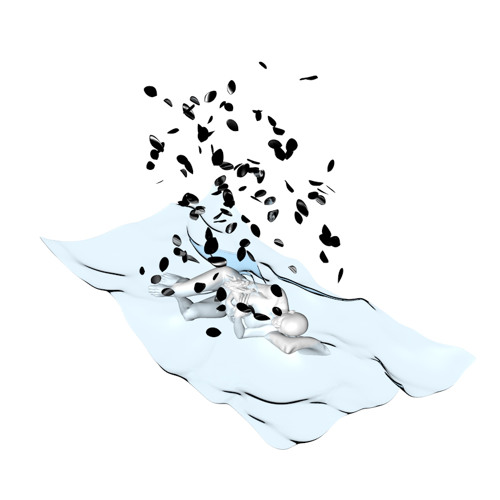Fragments of a Scene website, designed by Jon Lucas
Music is space. Music goes high and low, shallow and deep, left and right, in and out,
round and round. It goes here and there at the same time, underneath and over, it
faces in the same and in the opposite direction. It's among and alongside and between
things, it's behind and in front of things, it goes away from and towards things, it's
beyond things and quite within them. Its spatial changes map to bodies when it makes
them move, and in turn music moves according to an embodied imagination. Music is
more than sounds - at the very least it is sounds in spaces. More than that, music is
multimedia, it always means more than just sounds, it means sights, it means
proprioception, it means people. Music is a scene.
Fortunately, there are two senses in that word. A scene is a discrete moment in
theatre, a sequence on-stage with actors, script, speech, costume, props, lights,
background, gesture. Scenes are where things happen, framed both by the elevated
ground, the proscenium and by time. In a way, an entire play is a scene of scenes, and
forms a part of the wider scenes of life. This is where the other sense of the word
scene comes in. It's a term - one loaded with cultural capital, mostly that gained by
disavowing it - for musicians, fans, places, and performances (and speech, costume,
props, lights, background, gesture)clustered together, almost as if in a discrete
moment. The scene in New York in the 1960s: Andy Warhol, the Velvet Underground,
Nico and friends, one of many interconnected scenes at the time. Sometimes there's
only one scene, the scene, something to be in touch with - to be 'scene' is to be a part
of it. But the term can be used without that fancy fluff. It's usefulness comes from the
multimedia nature it inherits from theatre - a scene is never just sounds, never even
just musicians, but a network of artists in multiple mediums 'high' and 'low,' and even in
mediums that are not yet known as Art.
And scenes are difficult to piece together nowadays, especially as discrete moments
framed, like the theatre is, by certain locations in space and time. Berlin, London and
New York are still pretty good at that. But the internet has created social and aesthetic
connections that go beyond the more traditional conceptions of space and time. Don't
believe the rhetoric though: the internet has not destroyed time or space, much less
materiality. The internet is still 'in real life / IRL,' all art is still 'physical.' The aesthetics
of art and the internet, however, has been fascinated with the dilemma that it might not
be - whether that's a good thing (ushering a transcendent Utopia) or a bad thing (an
anxiety-inducing accumulation of blasphemous desires and accesses). At its best,
these two feelings occur at the same time.
What you have at Hau 2 on the 16th of April is Fragments of a Scene - in many
senses of a scene (and of fragments). The artists you will see make up something of a
scene, albeit partially: They are related in music, multimedia, social networks,
geography (to some extent), and are ultimately related by the fact that they are all
appearing tonight. They are all engaging with the modern age, which predominantly
means the digital world and its forms of expression. Yet while many artists in this vein
tend towards representation, figuration, even pastiche, these artists tend towards
abstraction and affect. Their perspective is less one of a detailed fantasy universe than
an onslaught of shapes and sensations boiling within a matrix of strong yet
indeterminate feelings.
Take Brood Ma. While there are occasional outlines of samples in James B. Stringer's
work, or the nuclear shadow of styles like grime (he's from London), at the centre is a
roiling mass of sonic shards, glittering and roaring like scales or teeth. Named after the
matriarchal figure in a culture of humanoid women with large scarabs for heads in
China Miéville's weird fiction Perdido Street Station, there is something deeply
insectoid about Brood Ma's modus operandi: biting, chewing, proliferating, attacking,
defending, all under a hard multipartite carapace filled with even weirder, visceral
matter beneath. Brood Ma works at the constituent level of sound itself, its very grains,
whipping digital codes into vortices as if they were pools of water. He distorts sounds
the way jpeg compression distorts Nature, and depixellates them, datamoshing them
until insides and outsides become part of a broader, more disorienting experience of
space.
This comes as no surprise, because James B. Stringer is part of a network of visually
trained multimedia artists coalesced around the Quantum Natives label, all long
interested in digital techniques of both sight and sound. One of the main nodes is
Stringer's friend Clifford Sage, an incredibly prolific sound-producer himself, with an
industrial synth style. At Hau 2, Sage will be providing the visuals to Stringer's
performance, both inviting us to draw some continuity across their respective fragments
of the abstracted scene.
Like many of Fragments of a Scene's artists, Forever Traxx is one of those producers
who instantly stokes curiosity with their mysterious and oblique Soundcloud profile.
Anonymous and not linking to any formal releases, digital or analogue, the mystery of
Forever Traxx is exponentially intensified by the music, which has been uploaded track
by track over the past four years. It's not just a surreal and somehow spiritual collage of
samples tied together by curiously mountainous passions (like the music of Elysia
Crampton, Chino Amobi and Total Freedom - big inspirations in the Soundcloud
collage scene), but the recurring idées fixe: lithe upper-frequency electronic lines,
babies crying, horror effects and other moments of piercing panic, urgent battalions of
drums, edits of tracks that bring the pitch up slightly as if to highlight some inner quality
(structural coherence? cuteness? absurdity?). Visually, the recurring motif is a rubbery
yet golden stickman who, as the apparent star of a ClipArt set, appears in a series of
symbolic scenarios in the Souncloud account's thumbnails and avatars. What's going
through this little guy's solid gold head, that he's beset by rapturously violent music?
He's the modern internet-user, perhaps, living a life that is both bland and breathtakingly,
monstrously intense.
Claude Speeed has explored the complexity and onslaught of the modern mindset
both as a band and as a solo electronic artist. Hailing from Scotland, his band
American Men released a dazzling EP Cool World in 2010, its crystal vistas and fractal
rhythms seeming to usher in a new decade for post-rock. Since then, Speeed has been
exploring sounds far and wide, each new Soundcloud upload an unexpected turn, from
the tweaking trance textures of 'Ambien Rave' to the roving vox of 'Clearing' and the
wailing new-Dark-Age wake of 'V (Spirit Leaves the Body)', via walls and walls of
distortion. At Fragments of a Scene, Claude Speeed will be performing with four amps
in stereo, so expect sounds so rich and intense you can taste them.
Also taking up these alpine electronic textures and inchoate drama is Club Cacao.
Another Soundcloud mystery whose account artwork competes with the music for
beauty, Club Cacao launches off from contemporary production styles from dance and
hip hop, ending up with compelling tracks like 'Go Off,' with its perfect euphoric
liberation, or the darker 'Balaclava,' an industrially twisted bounce over which a voice is
squeezed out, becoming both hilarious and terrifying.
Due to its uncanny ability to fuse disparate elements into a whole that makes a sense
one does not yet understand, but that one appreciates as the insights of a cybernetic
consciousness, DYNOOO's These Flaws Are Mine to War With was one of last year's
most interesting releases. His work has always suggested to me an emerging
intelligence, either artificial or that of the technological post-human, engaging with its
own mechanical realities as well as the curiously organic world around it. Piecing
together rainforest, desert and arctic tundra with an almost military palette of harsh
sounds and leaving it all suspended and rolling in a bubbling tank like a specimen or an
embryo, DYNOOO's conclusions could not have been reached by yesterday's
humanity, and they're as disquieting as they are beautiful.
Not to be confused with the English post-punk band active in the late 1970s and early
1980s, Punishment of Luxury is a Soundcloud experimentalist in a similar vein to
Forever Traxx, Crampton, Amobi and others. PoL creates strange yet urgent new
atmospheres for pop fragments to breathe in, as if they've suddenly been transported
to other planets. The procedure often seems to cause them to spin erratically in situ,
like broken bots in a massively multiplayer online role-playing game. Try the bizarre
union of Nicki Minaj and the Walker Brothers in 'BASSBREAKUP,' the desperate
product placement of 'BENZ BENZ BENZ,' plagued by alien anxiety, or the way the
ear's finger runs down the length of the male voice in 'TLS Male Vocal Choir Edit,' and
it's rough like a large iron nail file.
Using her voice to beckon a broader understanding of human culture and expression,
Hanne Lippard is somewhere between a poet and a performance artist. A book of her
texts, Nuances of No, was released in 2013. Her phrases often begin or end in the
same way as she accumulates concerns and information in a deceptively random
manner. These parallel the tics of language online, like the telling non-truths of
Google's autocompletes, or the attention-hijacking of sidebar advertising, or the
piecemeal, provisional conclusions of status updates. She narrates the Web 2.0 stream
of attention, but her voice is also perennially human, always seeking to elevate itself
while remaining intimate.
As she puts it, performer Bella Hager was 'torn and raised in Berlin, had to survive the
90s as a teenager.' She focused on pop divas such as Jennifer Lopez, soon feeling a
rupture between the art of being a women in music videos and the art of being a
women on the very own stage. After many years of research in different scenes, social
contexts and with different representations of gender, Bella decided to reunite with
Jenny, Britney, Christina and the rest to resolve this absurd struggle. During the first
act of appearance in Fragments of a Scene her character 'Britney Lopez' will enter
Christina Aguilera's music video to dive into the world of female pop artists in the late
90s, and will then take them into the year 2015 where a new extroverted sexuality
(Bella refers to herself as 'twerself') has left the former virginal image of the diva
behind.
Perhaps the only fair thing to say that all of these artists have in common (apart from
their appearance at Fragments of a Scene), is that they don't quite fit into the normal
distributions of creativity into particular places. Even musically, it is not entirely fitting to
call any of them merely 'producers' or 'musicians,' or to expect their work in clubs or
physical albums. And much of the time, their work is too specific, and too conversant
with the languages of pop and everyday life to feel at home in a gallery or concert hall
either. Many of them have taken the poetics of the visual and used them in a sound-led
medium, perhaps then turning back to re-incorporate the eye, which does not close as
it passes over an online account or a stage. However, nonetheless, these artists have
now carved out a space, somewhere between art and sound and music as it was
understood last century, a way to explore differences within the cohering locus of the
specific, to maintain that fragile equilibrium between novelty and similarity. Isn't that
precisely what a scene should be?














